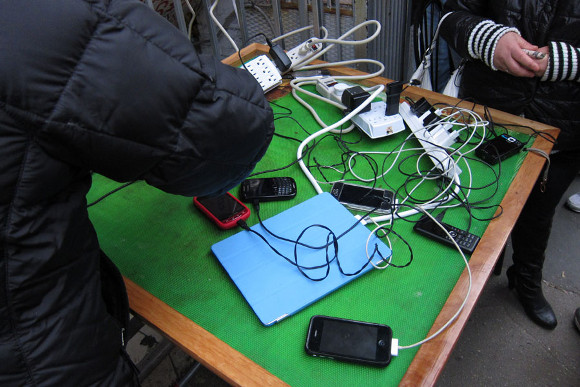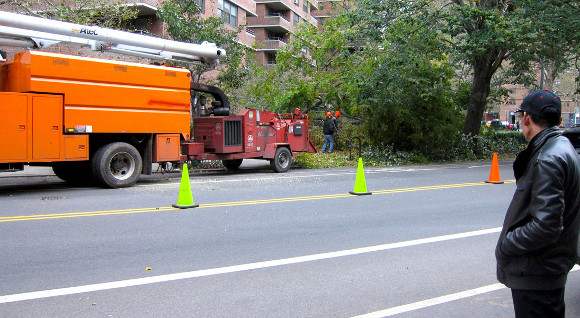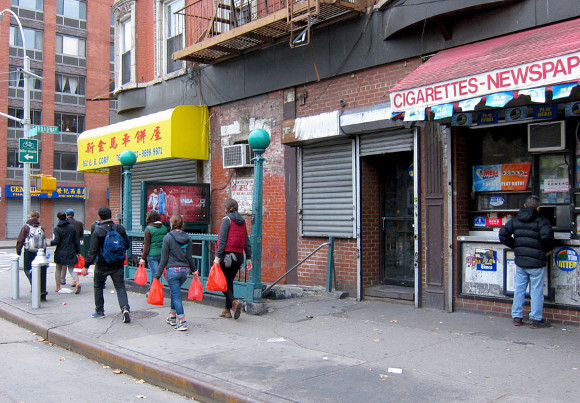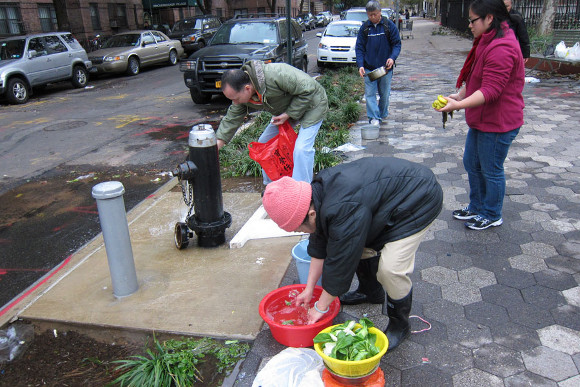A photo essay.
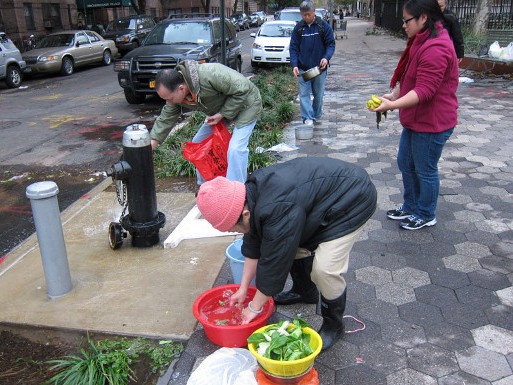
November 2, 2012
Electricity for sale! Makeshift stands have sprung up all over Chinatown, and entrepreneurs with generators are charging for electricity. Here, the red sign says: “Charge your phone.” Prices (as of Thursday) were $3-5 per charge. You can stand there for as long as you want until your device is charged up. The proprietor of my charging station said she had bought the generator for a little over a thousand dollars. In the half-hour that I waited for my phone to charge, I counted 11 paying customers. Phones, cameras, and iPads were being charged. “If anyone wants to trade phones, let me know,” a man half-joked. “I’m looking for an upgrade.”
The stand—a mahjong table—was busy the entire day, and sometimes the crowd swelled and overflowed into the street. Post-disaster, with nothing else to do except wait and commiserate, we felt free to talk to anyone—strangers, anyone standing nearby. Practical matters were discussed. When will the power come back on? Where does one get food? How have we been staying warm? One woman was especially excited to talk about the inevitability of Armageddon. “What are we charging our phones for then?” a man with slicked black hair and cloudy cataracts snorted. ” Let’s all go back to bed.”
“Where’s your charger?” Owners struggled to identify their own equipment. As devices got switched around, unplugged, rearranged for maximum charging power, some customers were worried that they were leaving with someone else’s gear.
New Yorkers waited for food and supplies at CAAAV‘s offices on 46 Hester Street. The lines wrapped around the block.
Workers tackled a downed tree in front of Seward Park Co-ops.
Volunteers went around Chinatown on Thursday to knock on doors, pass out flyers, and deliver supplies.
Hydrants have been left open, and residents without water have to haul water up several flights of stairs in makeshift buckets. Empty soy sauce buckets, stock pots, plastic bins, empty gallon milk jugs, and plastic bags are being used. Life congregates around these hydrants the way I imagine citizens would have gathered around the public fountains of old cities. Women did their laundry and washed vegetables while kids took off their shoes and washed their feet.
Elaine Chen, 30, said that she and her family have been coming down to the hydrants to fill up water at least ten times a day. Each person takes two turns each. She told me that her situation was not even as bad as her mother’s, who lives in a building on the 14th floor. Elaine hikes up the 14 dark flights to bring water and to check up on her mother. In addition, Elaine is mother to an infant, and her grandmother underwent major surgery the day of the hurricane. “It’s frustrating,” she said. “I’ve been living here for almost twenty hears. We’ve never seen anything this bad. A few blackouts maybe, but nothing like this.” Overhearing this, another man at the fountain said, “This can’t go on for much longer,” adding that old people have to be evacuated from their apartments because they leave the gas running—an attempt to warm up using the stove burners, perhaps. “The fire department just came last night. They took out a lot of old people. They need help.”
Residents from the Alfred E Smith houses on Catherine and South lined up to wait for FEMA supplies. They were told that they’d be receiving water, hot food, and bread. After waiting for three hours, a group of elderly Chinese women told me that they were cold and tired and confused about what they were standing there waiting for. “Are they coming or not?” They wanted to know. I acted as interpreter and asked the police officers overseeing the extremely orderly line if FEMA was coming. It was getting dark. “We don’t know,” they said. “They’ve been telling us five minutes. It’s been over two hours.”


